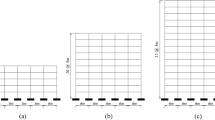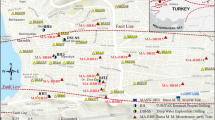Abstract
Major damage has been reported in hilly areas after major earthquakes, primarily because of two special conditions: the variation in the seismic ground motion due to the inclined ground surface and the irregularities caused by a stepped base level in the structure. The aim of this study is to evaluate possible differences in the responses of Chilean hillside buildings through numerical linear-elastic and nonlinear analyses. In the first step, a set of response-spectrum analyses were performed on four simplified 2D structures with mean base inclination angles of 0°, 15°, 30°, and 45°. The structures were designed to comply with Chilean seismic codes and standards, and the primary response parameters were compared. To assess the seismic performance of the buildings, nonlinear static (pushover) and dynamic (time-history) analyses were performed with SeismoStruct software. Pushover analyses were used to compare the nonlinear response at the maximum roof displacement and the damage patterns. Time-history analyses were performed to assess the nonlinear dynamic response of the structures subjected to seismic ground motions modified by topographic effects. To consider the topographic modification, acceleration records were obtained from numerical models of soil, which were calculated using the rock acceleration record of the Mw 8.0 1985 Chilean earthquake. Minor differences in the structure responses (roof displacements and maximum element forces and moments) were caused by the topographic effects in the seismic input motion, with the highly predominant ones being the differences caused by the step-back configuration at the base of the structures. High concentrations of shear forces in short walls were observed, corresponding to the walls located in the upper zone of the foundation system. The response of the structures with higher angles was observed to be more prone to fragile failures due to the accumulation of shear forces. Even though hillside buildings gain stiffness in the lower stories, resulting in lower design roof displacement, maximum roof displacements for nonlinear time-history analyses remained very close for all the models that were primarily affected by the drifts of the lower stories. Additionally, vertical parasitic accelerations were considered for half the time-history analyses performed here. The vertical component seems to considerably modify the axial load levels in the shear walls on all stories.
Similar content being viewed by others
References
ACI (2014), Building Code Requirements for Structural Concrete and Commentary ACI 318-08, American Concrete Institute.
Ashford S and Sitar N (1997), “Analysis of Topographic Amplification of Inclined Shear Waves in a Steep Coastal Bluff,” Bulletin of the Seismological Society of America. 87(3): 692–700.
Ashford S, Sitar N, Lysmer J and Deng N (1997), “Topographic Effects on the Seismic Response of Steep Slopes,” Bulletin of the Seismological Society of America, 87(3): 701–709.
Assimaki D and Kausel E (2007), “Modified Topographic Amplification Factors for a Single-Faced Slope due to Kinematic Soil-Structure Interaction,” Journal of Geotechnical and Geoenvironmental Engineering, 133(11): 1414–1431. https://doi.org/10.1061/(ASCE)1090-0241(2007)133:11(1414)
BCJ (1997), Structural Provisions for Building Structures, Tokyo: Building Center of Japan.
Birajdar BG and Nalawade SS (2004), “Seismic Analysis of Buildings Resting on Sloping Ground,” In 13th World Confeernce on Earthquake Engineering (pp. 1–12).
Bouckovalas GD and Papadimitriou AG (2005), “Numerical Evaluation of Slope Topography Effects on Seismic Ground Motion,” Soil Dynamics and Earthquake Engineering, 25(7–10): 547–558. https://doi.org/10.1016/j.soildyn.2004.11.008
Celebi M (1987), “Topographical and Geological Amplifications Determined from Strong-Motion and Aftershock Records of the 3 March 1985 Chile Earthquake,” Bulletin of the Seismological Society of America, 77(4): 1147–1167.
CEN (2004), EuroCode 8: Design of Structures for Earthquake Resistance — Part 1: General Rules, Seismic Actions and Rules for Buildings, Brussels: European Committee for Standardization.
Cousiño J (2017), Evaluación de la Resupuesta Sísmica en la Superficie de Terreno con Pendiente Superior a 15° Para Efectos de Diseño de una Edificación.
CSI (2016), ETABS16: Structural Software for Building Analysis and Design, Computers and Structures Inc.
Diaz-Segur EG (2017), “Incertidumbres en la Estimación del Periodo Fundamental de Terrenos Inclinados,” Obras y Proyectos, 21: 38–44.
Elnashai AS and Papazoglou AJ (1997), “Procedure and Spectra for Analysis of RC Structures Subjected to Strong Vertical Earthquake Loads,” Journal of Earthquake Engineering (Vol. 1). https://doi.org/10.1080/13632469708962364
Ghosh R and Debbarma R (2017), “Performance Evaluation of Setback Buildings with Open Ground Storey on Plain and Sloping Ground Under Earthquake Loadings and Mitigation of Failure,” International Journal of Advanced Structural Engineering, 9(2): 97–110. https://doi.org/10.1007/s40091-017-0151-3
Grelle G, Bonito L, Rosalba M, Iacurto S, Madiai C, Revellino P and Sappa G (2021), “Topographic Effects Observed at Amatrice Hill During the 2016–2017 Central Italy Seismic Sequence,” Earthquake Engineering and Engineering Vibration, 20(1): 63–78. https://doi.org/10.1007/s11803-021-2005-z
Hirde SK and Shelar NK (2015), “Effect of Positioning of RC Shear Walls on Seismic Performance of Buildings Resting on Plain and Sloping Ground,” International Journal of Current Engineering and Technology, 5(3): 1659–1665.
Hosseinzadeh N (2008), “Vertical Component Effect of Earthquake in Seismic Performance of Reinforced Concrete Bridge Piers,” Proceedings of the 14th World Conference on Earthquake Engineering, Beijing, China.
ICC (2012), IBC International Building Code, USA: International Code Council.
INN (2008), NCh 430.Of2008: Hormigón Armado — Requisitos de diseño y cálculo, Chile.
INN (2009a), Nch 433.Of1996 Mod. 2009: Diseño Sísmico de Edificios, Chile.
INN (2009b), NCh1537.Of2009: Diseño Estructural de Edificios — Cargas Permanentes y sobrecargas de uso, Chile.
INN (2010), NCh 3171.Of2010: Diseño Estructural — Disposiciones Generales y Combinaciones de Carga, Chile.
Isari M and Tarinejad R (2021), “Introducing an Effective Coherence Function to Generate Non-Uniform Ground Motion on Topographic Site Using Time-Domain Boundary Element Method,” Earthquake Engineering and Engineering Vibration, 20(1): 89–100. https://doi.org/10.1007/s11803-021-2007-x
Kaushik S and Dasgupta K (2019), “Seismic Behavior of Slab-Structural Wall Junction of RC Building,” Earthquake Engineering and Engineering Vibration, 18(2): 331–349. https://doi.org/10.1007/s11803-019-0507-8
Khan S, Van Der Meijde M, Van Der Werff H and Shafique M (2020), “The Impact of Topography on Seismic Amplification During the 2005 Kashmir Earthquake,” Natural Hazards and Earth System Sciences, 20(2): 399–411. https://doi.org/10.5194/nhess-20-399-2020
Kumar S and Chakraborty SK (2020), “Influence of Scattering of SH-Waves in Dynamic Interaction of Shear Wall with Soil Layers,” Earthquake Engineering and Engineering Vibration, 19(3): 583–595. https://doi.org/10.1007/s11803-020-0582-x
Mander JB, Priestley N and Park R (1988), “Theoretical Stress-Strain Model for Confined Concrete,” Journal of Structural Engineering, 114(8): 1804–1826.
Menegotto M and Pinto PE (1973), “Method of Analysis for Cyclically Loaded RC Plane Frames Including Changes in Geometry and Non-Elastic Behaviour of Elements Under Combined Normal Force and Bending,” In Symposium on the Resistance and Ultimate Deformability of Structures Acted on by Well Defined Repeated Loads, International Association for Bridge and Structural Engineering (pp. 15–22), Zurich, Switzerland.
Mohammad Z, Baqi A and Arif M (2017), “Seismic Response of RC Framed Buildings Resting on Hill Slopes,” Procedia Engineering, 173: 1792–1799. https://doi.org/10.1016/j.proeng.2016.12.221
Papadimitriou A and Chaloulos Y (2010), “Aggravation of the Peak Seismic Acceleration in the Vicinity of 2D Hills, Canyons and Slopes,” Proc. Fifth International Conference of Recent Advances in Geotechnical Earthquake Engineering and Soil Dynamics, 1–12.
Park R (1988), “Ductility Evaluation From Laboratory and Analytical Testing,” In Ninth World Conference on Earthquake Engineering, Tokyo-Kyoto, Japan.
Paulay T and Priestley MJN (1992), Seismic Design of Reinforced Concrete and Masonry Buildings, Wiley Interscience.
Pitilakis D (2009), “Topographic Irregularities and Soil-Foundation-Structure Interaction,” Proceedings of the 3rd Greece-Japan Workshop on Seismic Design of Foundations, Innovations in Seismic Design, and Protection of Cultural Heritage.
Sable KS and Nagargoje SM (2012), “Seismic Performance of Multi-Soreyed Building on Sloping Ground,” Elixir Elec. Engg, 53: 11980–11982.
Seismosoft (2018), “SeismoStruct 2018 — A Computer Program for Static and Dynamic Nonlinear Analysis of Framed Structures,” Available from http://www.seismosoft.com.
Shrestha B (2009), “Vertical Ground Motions and Its Effect on Engineering Structures: a State-of-the-Art Review,” Proceeding of International Seminar on Hazard Management for Sustainable Development, (November 2009). https://doi.org/10.13140/2.1.2863.6165
Singh Y, Gade P, Lang DH and Erduran E (2012), “Seismic Behavior of Buildings Located on Slopes-An Analytical Study and Some Observations from Earthquake of September 18, 2011,” Proceedings of the 15th World Conference of Earthquake Engineering. Lisbon, Portugal.
Surana M, Singh Y and Lang DH (2015), “Seismic Fragility Analysis of Hill-Buildings in Indian Himalayas,” In SECED 2015 Conference: Earthquake Risk and Engineering Towards a Resilient World, Cambridge, UK.
Tarinejad R, Isari M and Sohrabi-Bidar A (2020), “A New Solution to Estimate the Time Delay on the Topographic Site Using Time Domain 3D Boundary Element Method,” Earthquake Engineering and Engineering Vibration, 19(3): 611–623. https://doi.org/10.1007/s11803-020-0584-8
Tarinejad R, Isari M and Taghavi Ghalesari A (2019), “A New Boundary Element Solution to Evaluate the Geometric Effects of the Canyon Site on the Displacement Response Spectrum,” Earthquake Engineering and Engineering Vibration, 18(2): 267–284. https://doi.org/10.1007/s11803-019-0503-z
Thakur A, Ashish DK and Verma SK (2019), “Influence of Rooftop Telecommunication Tower on Set Back-Step Back Building Resting on Different Ground Slopes,” Earthquake Engineering and Engineering Vibration, 18(2): 351–362. https://doi.org/10.1007/s11803-019-0508-7
Yuan Y (2008), “Impact of Intensity and Loss Assessment Following the Great Wenchuan Earthquake,” Earthquake Engineering and Engineering Vibration, 7(3): 247–254. https://doi.org/10.1007/s11803-008-0893-9
Acknowledgement
The authors gratefully acknowledge the Pontificia Universidad Católica de Valparaíso as part of VRIEAPUCV Project No. 39.394/2019 for their partial financial support of the present study. The authors also acknowledge the support of the Council of the International Geoscience Program (UNESCO), through the Seismic Vulnerability of Buildings Located on Hillsides Project, Case study: Latin American Countries Project, No. 701: 2020–2022.
Author information
Authors and Affiliations
Corresponding author
Additional information
Supported by
Pontificia Universidad Católica de Valparaíso as part of VRIEA-PUCV Project No. 39.394/2019, Case study: Latin American Countries Project, No. 701: 2020–2022
Rights and permissions
About this article
Cite this article
Gómez, M.A., Díaz-Segura, E.G. & Vielma, J.C. Nonlinear numerical assessment of the seismic response of hillside RC buildings. Earthq. Eng. Eng. Vib. 20, 423–440 (2021). https://doi.org/10.1007/s11803-021-2029-4
Received:
Accepted:
Published:
Issue Date:
DOI: https://doi.org/10.1007/s11803-021-2029-4




